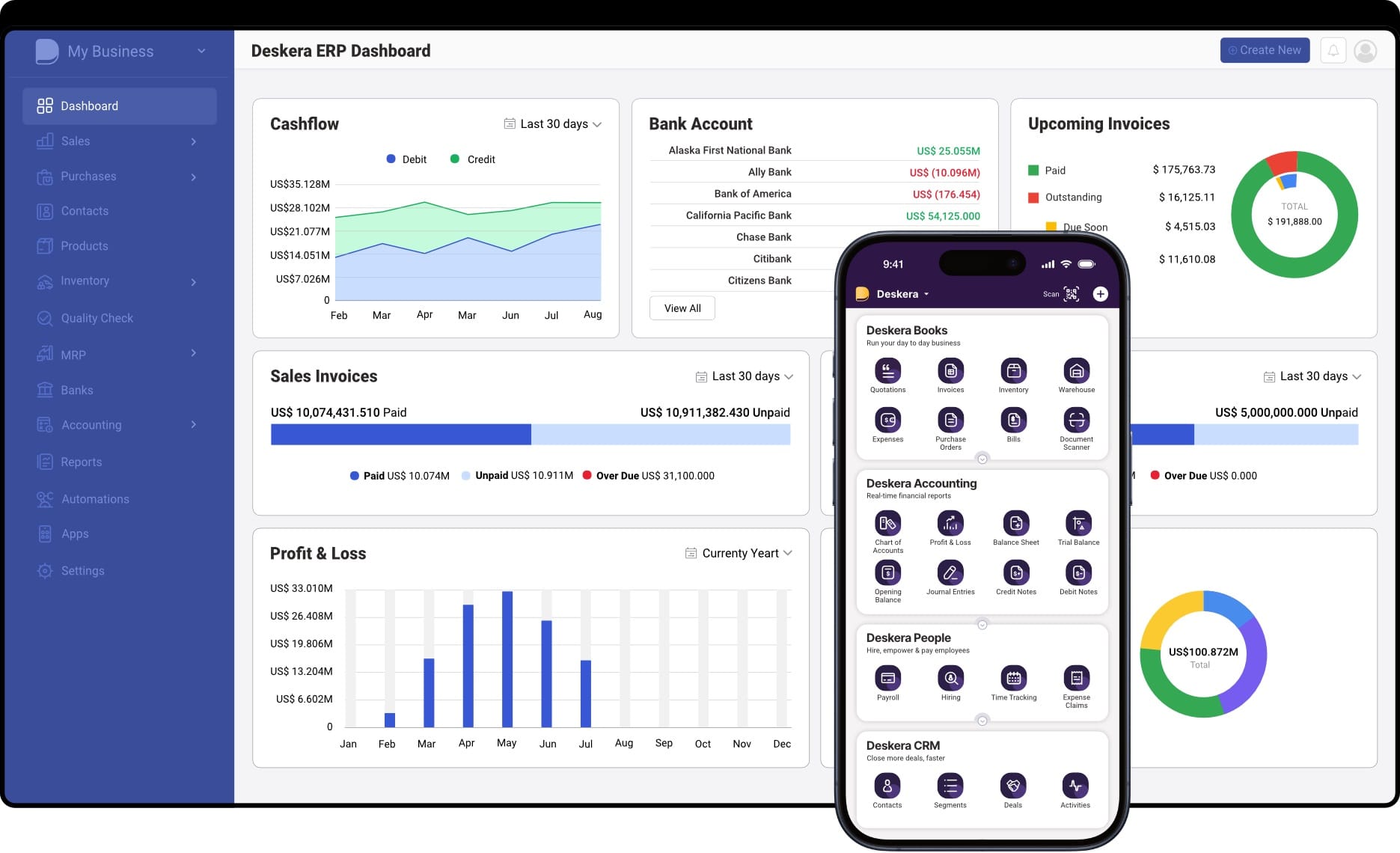Have you ever wondered how businesses keep their sales, inventory, and accounting perfectly in sync across multiple stores and online platforms? The answer lies in POS (Point of Sale) integration, a powerful tool that connects your sales system with other essential business software like inventory management, accounting, and CRM. By linking these systems, companies can manage their operations in real time, reduce manual work, and deliver a smoother experience to customers.
POS integration is no longer a luxury — it’s a business necessity. In fact, retailers implementing integrated POS systems report up to 566% ROI in the first year thanks to reduced costs, faster sales processes, and improved customer satisfaction. As retail competition intensifies, the ability to unify data across multiple channels becomes a key differentiator for growth and efficiency.
The global POS market is also experiencing rapid expansion — growing from $33.41 billion in 2024 to an estimated $110.22 billion by 2032. This surge is driven by the rise of cloud-based and AI-powered POS systems, enabling businesses to achieve omnichannel sales and real-time synchronization across physical and digital stores. These advanced systems empower decision-makers with accurate insights while enhancing the customer experience through speed and personalization.
Modern ERP platforms like Deskera ERP take POS integration even further. Deskera connects your sales, inventory, and accounting in a single unified dashboard — powered by automation and real-time analytics. With features like mobile accessibility, AI-driven insights from Deskera’s assistant David, and seamless integration across departments, businesses can streamline workflows, boost accuracy, and scale faster. In short, Deskera ERP turns POS integration from a technical upgrade into a strategic advantage.
What Is POS Integration?
POS integration is the process of connecting your Point of Sale (POS) system with other essential business applications — such as accounting software, inventory management systems, CRM platforms, payment gateways, and eCommerce stores. This integration enables seamless data exchange between systems, ensuring that every transaction automatically updates all related records across departments in real time.
In simple terms, POS integration creates a centralized and automated flow of information that starts the moment a sale occurs — whether at a physical register or an online checkout. Details like transaction amount, payment method, discounts, taxes, date and time, and customer information are instantly captured by the POS and shared with connected systems. As a result, your accounting books, stock levels, and customer profiles are updated automatically, without manual input or risk of error.
Before integration became common, businesses often spent hours on manual tasks like reconciling sales data, updating inventory after every purchase, or re-entering order details into accounting software. POS integration eliminates these inefficiencies by enabling real-time synchronization and automated updates across all platforms.
Ultimately, POS integration gives businesses a unified, accurate, and up-to-date view of their operations, helping teams make smarter, faster decisions. It not only improves efficiency but also enhances customer satisfaction by ensuring consistent experiences across multiple sales channels.
Components of POS Integration
When it comes to POS integration, every business has unique operational needs and system setups. However, most integrations can be grouped into three key components — platform integration, location integration, and channel integration. Together, these ensure that your sales, customer data, and inventory remain unified and up to date across all systems and touchpoints.
1. Platform Integration
Modern businesses rely on multiple software tools to operate efficiently — from accounting and CRM systems to marketing platforms and loyalty programs. Platform integration connects these tools directly to your POS system, allowing all data to sync automatically. For example, when your POS links to a loyalty or financing platform, customers receive personalized offers, smooth payment options, and accurate reward tracking — all without manual updates.
This seamless connectivity not only eliminates data silos but also saves time, reduces human error, and enhances customer engagement. With all platforms working together, business owners can focus more on strategy and service rather than managing repetitive administrative tasks.
2. Location Integration
For multi-store businesses, managing data consistency across locations can be a major challenge. Location integration ensures that all branches of your business — whether two or twenty — operate on synchronized data. When a sale happens at one location, your POS system automatically updates inventory counts, customer records, and financial data across every store in real time.
This integration provides full visibility into each store’s activity, helping management track performance and stock levels effortlessly. It also improves customer service — if a customer asks about product availability at another branch, staff can instantly check and respond using live data instead of making manual calls or estimates.
3. Channel Integration (Online and Offline)
Today’s customers expect the flexibility to shop wherever they prefer — online, in-store, or through mobile. Channel integration bridges the gap between online and offline sales systems, ensuring a consistent and connected shopping experience. For example, when a customer buys an item online and chooses Buy Online, Pick Up In-Store (BOPIS), the integrated POS system automatically updates inventory and records the sale across both channels.
A McKinsey study found that 56% of consumers use both online and offline channels to make purchases, highlighting the need for unified retail operations. By connecting your eCommerce platform with your POS, businesses can maintain accurate stock levels, prevent overselling, and provide customers with a seamless omnichannel experience — no matter where they shop.
Difference Between an Integrated POS and a Traditional POS System
When choosing a POS system, it’s important to understand the distinction between traditional POS systems and integrated POS systems, as they serve very different business needs.
How POS Integration Works
POS integration works by connecting your Point of Sale (POS) system with other essential business tools, allowing them to share data in real time. This seamless exchange ensures that sales, inventory, accounting, and customer data remain synchronized, improving efficiency, accuracy, and the overall customer experience. Most modern POS systems achieve this connectivity through APIs, middleware, or native integrations, depending on the complexity of the business environment.
Step 1: Setting Up the Integration
The first step is linking your POS system with tools like inventory management, CRM systems, eCommerce platforms, and accounting software. APIs often serve as the “connectors” that allow these systems to communicate. Some vendors offer native integrations, where the connection is prebuilt, while others rely on middleware to route data between legacy systems and newer platforms without custom coding.
Step 2: Real-Time Data Syncing
Once connected, data flows seamlessly between your POS and other systems. For example, when a sale occurs, the POS instantly updates inventory levels and records the transaction in accounting software, ensuring all systems reflect the latest information. Real-time synchronization prevents discrepancies, reduces manual work, and keeps your business running smoothly.
Step 3: Automated Transaction Processing
During each sale — whether in-store or online — the POS system captures critical details such as product information, payment method, discounts, and customer data. This information is automatically sent to connected systems, including payment gateways and financial software, allowing for secure, accurate, and efficient transaction processing.
Step 4: Inventory and Order Fulfillment
Integrated POS systems automatically adjust inventory across all locations and channels whenever a sale occurs. In omnichannel operations, this prevents overselling, ensures stock accuracy, and supports smooth order fulfillment. Orders are tracked across both online and offline channels, ensuring consistency and improving customer satisfaction.
Step 5: Reporting and Business Insights
Finally, data from sales, inventory, and customer interactions is aggregated into centralized dashboards and reports. Business owners gain actionable insights into sales trends, stock levels, and customer behavior, enabling smarter decisions and strategic planning for growth.
POS integration essentially transforms your POS system from a simple sales tool into a central hub for your business operations, connecting multiple platforms, automating workflows, and providing real-time visibility into your business.
Types of POS Integrations
Modern POS systems rarely operate in isolation. To streamline operations, reduce manual work, and maintain accurate records, POS systems are commonly integrated with other business applications. These integrations ensure data flows smoothly across systems, providing real-time updates and a unified view of operations.
Here are the most common types of POS integrations and how each supports daily business activities:
1. CRM Integration
Integrating a POS system with a Customer Relationship Management (CRM) platform centralizes customer data and helps businesses deliver personalized experiences. For instance, a café can track customer purchase frequency and automatically apply loyalty discounts at checkout.
Each transaction updates customer profiles with details like spending habits and preferred payment methods. This data enables marketing teams to identify high-value customers, run targeted promotions, and improve overall customer engagement.
2. eCommerce Integration
A POS connected to an eCommerce platform ensures in-store and online sales are synchronized. For example, a clothing retailer can prevent overselling by immediately updating stock online when an item is sold in-store. This integration also supports Buy Online, Pick Up In-Store (BOPIS) orders, aligning order details across channels and providing a smooth, consistent shopping experience for customers.
3. Accounting Integration
POS integration with accounting software automates the flow of revenue and expense data into financial records. Restaurants and retail chains can instantly post daily sales into the general ledger, reducing manual entry and minimizing reconciliation errors.
Integrated POS systems capture taxes, discounts, tips, and payment types, ensuring accurate journal entries and cleaner month-end closes. For multi-location businesses, consolidated data from all registers or stores enhances consistency in financial reporting.
4. Inventory Management Integration
Linking your POS to inventory management software enables real-time stock updates for every transaction, including sales, returns, and adjustments.
Automated inventory tracking helps prevent stockouts and supports timely reordering. When inventory, POS, and eCommerce systems are integrated, stock levels remain accurate across all channels, avoiding overselling and improving overall operational efficiency.
5. ERP Integration
Integrating a POS with an Enterprise Resource Planning (ERP) system connects sales with finance, supply chain, and operations data in one platform. This integration provides a complete business overview, allowing purchasing teams to plan inventory accurately while finance teams see real-time revenue updates.
For multi-location businesses, POS–ERP integration consolidates sales and inventory data across stores, supporting better decision-making and enterprise-wide planning.
6. Payment Processing Integration
Every POS system connects to a payment processor, but integrated systems can handle multiple payment types — credit cards, mobile wallets, and third-party delivery apps — through a single dashboard. This ensures that all payments are captured alongside sales data, simplifying reconciliation and improving transaction accuracy.
7. Marketing Platform Integration
POS systems can also integrate with marketing automation platforms to trigger campaigns based on customer purchase behavior. For example, after a customer buys a product, the system can automatically send personalized email promotions, discount codes, or reminders for repeat purchases, helping businesses drive customer loyalty and repeat sales.
Benefits of POS Integration
POS integration offers numerous advantages, helping businesses streamline operations, improve accuracy, and elevate the overall customer experience. By connecting a POS system with tools like inventory management, CRM, accounting software, and eCommerce platforms, businesses gain greater control, automation, and insight across all operations.
Improved Data Analytics & Real-Time Insights
An integrated POS centralizes all business data into a single platform, offering real-time visibility into sales, inventory levels, and customer behavior. Managers can detect trends instantly, such as rising demand for a particular product, potential stock shortages, or peak shopping hours that require additional staffing.
Customizable dashboards allow teams to focus on the most relevant metrics, helping streamline decision-making, optimize workflows, and plan strategically for growth. The system also enables predictive analytics, letting businesses anticipate market changes and adjust inventory or marketing campaigns proactively.
Unified Inventory Management
Inventory management becomes significantly more efficient with POS integration. Every transaction — whether online or in-store — is automatically reflected in inventory records, ensuring stock levels are always accurate. Businesses can set up automated reorder alerts and maintain consistent product information across multiple locations.
Integrating inventory with eCommerce platforms ensures online stock reflects in-store sales, preventing overselling and missed opportunities. This level of automation reduces manual labor, minimizes errors, and allows staff to focus on customer service rather than repetitive updates.
Enhanced Security
POS integration enhances security by incorporating features such as automated encryption of all data transfers, regular software updates, and advanced access controls. Sensitive payment data, customer information, and financial records are protected against cyber threats.
Additionally, an integrated system provides detailed audit trails of all transactions, helping businesses detect anomalies or unauthorized access quickly, and comply with industry standards and regulations.
Optimized Resource Allocation
By automating routine tasks — such as updating inventory, posting sales transactions to accounting, and generating reports — businesses can allocate human resources more efficiently.
Employees spend less time on manual data entry or reconciling errors and more time on high-value activities like assisting customers, improving operations, or implementing business strategies. This optimization improves productivity, reduces overhead costs, and ensures teams can operate at maximum efficiency.
Cost Savings
POS integration reduces operational costs in multiple ways. Automation minimizes manual work, reduces errors, and decreases the need for overtime or additional staffing.
Accurate inventory tracking prevents overstocking and waste, and integrated reporting highlights areas for cost optimization. Businesses also save on reconciliation time for financial data and streamline accounting processes, resulting in a higher ROI and more predictable financial outcomes.
Better Product Availability and Customer Experience
Integrated POS systems ensure that customers encounter accurate stock information across all channels, whether shopping online or in-store.
This prevents cart abandonment due to out-of-stock items and provides consistent pricing, promotions, and payment options across locations.
Faster, automated checkout and real-time transaction processing contribute to a frictionless shopping experience, improving satisfaction and loyalty.
Improved Accuracy in Sales and Inventory Tracking
Human errors in manual systems can lead to costly discrepancies. Integrated POS systems eliminate these risks by automatically syncing data across all business functions.
Sales, inventory, and financial records remain consistent and accurate, providing a single source of truth for decision-making. Businesses can track trends, forecast demand, and maintain precise accounting records with confidence.
Personalized Customer Engagement
Integration with CRM and marketing platforms allows businesses to leverage detailed customer data to create tailored promotions, loyalty rewards, and personalized recommendations.
Shoppers receive offers that match their preferences and purchase history, both online and in-store. This fosters stronger relationships, drives repeat purchases, and enhances long-term customer retention.
Omnichannel Consistency
An integrated POS ensures seamless operations across multiple channels. Online, offline, and mobile sales are all synchronized, providing customers with a consistent experience regardless of how they choose to shop.
Orders, returns, and exchanges are managed efficiently, inventory remains accurate, and business-wide insights are always up to date, enabling truly omnichannel retail operations.
Troubleshooting Common Challenges of POS Integration
While POS integration can significantly streamline operations, businesses often encounter challenges during implementation or daily use. These issues typically involve system compatibility, data security, and user adoption, but with the right strategies, they can be effectively managed.
1. System Compatibility
Compatibility problems are common when POS systems need to connect with various hardware and software, such as payment devices, barcode scanners, accounting software, or inventory management platforms. Symptoms may include failed data syncs, missing fields, or unsupported peripherals.
How to troubleshoot:
- Create a compatibility matrix listing your POS version, connected hardware, and each system it integrates with.
- Use middleware or adapters as a temporary bridge if certain systems cannot communicate natively.
- Conduct a pilot program before full rollout and establish a rollback plan to revert changes if issues arise.
- After implementation, track success with metrics such as error rates, sync latency, and failed transactions.
2. Data Security and Privacy
Integrating POS with other systems increases the risk of data breaches or compliance violations if sensitive customer information is improperly stored or transmitted.
How to troubleshoot:
- Implement tokenization to replace card numbers with random tokens.
- Use point-to-point encryption (P2PE) to secure data from capture to payment processor.
- Ensure workflows comply with PCI DSS standards and other applicable regulations.
- Set up alerts for anomalies, such as unusual transaction volumes or failed token calls.
- Perform regular security testing, including quarterly scans and rotation of encryption keys, to maintain ongoing protection.
3. User Adoption and Workflow Changes
Even when integrations work correctly, failure can occur if employees do not adopt new workflows enabled by the POS system. For example, cashiers might need to capture customer emails for CRM syncing, or servers may have to enter orders directly into tablets routed to the kitchen. Ignoring these steps can result in incomplete or inaccurate data.
How to troubleshoot:
- Include role-based training as part of the rollout plan.
- Provide quick reference guides and in-app prompts to guide staff during transactions.
- Identify team champions who can mentor peers and collect feedback during the first months.
- Monitor adoption by tracking transaction speed, error rates, and employee confidence.
4. Data Synchronization Delays
Sometimes, integrated systems experience delays in syncing data, leading to temporary discrepancies in inventory, sales records, or financial reporting.
How to troubleshoot:
- Check your network connectivity and server performance to ensure data flows smoothly.
- Prioritize real-time sync for critical systems like inventory and payment processing.
- Schedule batch updates during low-traffic periods to reduce the load on the system.
5. Scalability Challenges
As businesses grow and add more locations or sales channels, integrations can become more complex and harder to maintain.
How to troubleshoot:
- Plan integrations with scalability in mind, ensuring new locations and systems can connect without disrupting operations.
- Use cloud-based or modular POS solutions that can adapt as your business expands.
- Continuously monitor performance metrics to identify bottlenecks and address them proactively.
Effectively troubleshooting POS integration challenges requires a mix of technical solutions, process adjustments, and employee training. By anticipating these common issues and implementing proactive measures, businesses can ensure smooth operations, secure data handling, and high user adoption.
How to Choose the Right POS Integrations
Selecting the right POS integrations is critical for ensuring smooth operations, accurate data flow, and long-term scalability. It’s not just about picking software—it’s about choosing integrations that align with your business goals, enhance efficiency, and provide actionable insights.
Here’s a comprehensive approach to making the right decision:
1. Audit Your Current Processes
Start by mapping out how your existing systems interact and identifying pain points. Are teams spending excessive time reconciling sales manually? Are orders delayed due to slow data transfer between platforms? By pinpointing these gaps, you can prioritize which integrations will have the greatest impact.
For example, connecting your POS to an eCommerce platform can speed up order fulfillment, while CRM integration can enhance customer insights, and accounting integration reduces reconciliation errors. Understanding your workflow is the first step toward smart integration.
2. Define System Requirements Early
Before evaluating software, determine the outcomes you expect from integrations. Consider questions like: Which decisions should this data support? Who needs access, and how quickly? Translate these goals into technical requirements for each system—such as multi-entity ledger support in accounting or detailed customer profile capture in a CRM.
Evaluate API support, hardware compatibility, mobile POS functionality, and security standards such as PCI DSS or GDPR compliance. Clearly defining requirements ensures that the integrations deliver real business value.
3. Evaluate Scalability
Your POS integration should grow with your business. Consider future transaction volumes, product counts, locations, and sales channels. The system should support omnichannel operations like buy online/pick up in-store (BOPIS) and seasonal or promotional spikes.
For multi-location or multi-currency businesses, confirm that the integrations can handle tax rules, reporting hierarchies, and other complexities without requiring a complete replatform later.
4. Consider Industry-Specific or Custom Features
Some industries require unique integrations. Restaurants may need POS connectivity with tableside ordering or delivery platforms, while retailers may require serial number tracking and barcode workflows.
Highly regulated sectors, like pharmacies or alcohol sales, may require compliance reporting integrations. If your business has specialized needs, check for API availability or low-code extensions that allow custom integrations to reduce manual workarounds.
5. Assess Vendor Reliability
The quality of your POS vendor directly affects integration success. Investigate uptime guarantees, support responsiveness, and historical reliability. Ask for customer references that match your business size and complexity.
Clarify how failure scenarios are handled—for example, if a payment processor goes offline, how are transactions queued and retried? A reliable vendor provides transparent support and quick resolution to keep your operations running smoothly.
6. Factor in Total Cost of Ownership (TCO)
Consider all costs over the lifecycle of the integration: implementation, migration, connector subscriptions, per-transaction fees, training, and ongoing maintenance. Evaluate both average and peak transaction volumes to understand how costs may scale. Hidden fees, such as middleware charges or costs for switching providers, should also be factored in. A thorough TCO analysis helps avoid expensive surprises and ensures a positive ROI.
7. Prioritize Ease of Use and Training
Even the most powerful POS integration can fail if your team struggles to use it. Look for systems with intuitive interfaces, minimal learning curves, and clear workflows. Role-based training, quick-reference guides, and in-app prompts can help employees adapt quickly, ensuring accurate data capture and seamless operations.
8. Integration with Existing Tools
Ensure the POS system integrates smoothly with your current tools, including accounting software, CRM, ERP, and eCommerce platforms. Avoid solutions that require abandoning systems you already rely on. The goal is to maintain a connected ecosystem, where data flows automatically between systems, reducing manual work and errors.
A well-planned POS integration strategy balances your current operational needs with future growth, compliance requirements, and industry-specific workflows. By auditing processes, defining requirements, evaluating scalability, and carefully assessing vendors, businesses can select integrations that drive efficiency, enhance customer experience, and maximize ROI.
Future of POS Integration
The landscape of POS integration is evolving rapidly, driven by technological advancements, changing consumer expectations, and the increasing complexity of retail and service operations. Businesses that adopt forward-looking POS integrations can gain a competitive edge through automation, data-driven insights, and seamless omnichannel experiences. Here’s what the future looks like:
1. Cloud-Based and Mobile POS Systems
Cloud technology is becoming the backbone of modern POS integrations. Cloud-based POS systems allow real-time data syncing across multiple locations and devices, making inventory, sales, and customer information accessible anywhere, anytime.
Mobile POS solutions are also gaining traction, enabling sales associates to process transactions, check inventory, and engage customers directly on the sales floor or in remote locations. This flexibility enhances customer experience and operational efficiency while reducing infrastructure costs.
2. AI and Predictive Analytics
Artificial intelligence (AI) is set to transform POS integrations by providing predictive analytics and actionable insights. AI can analyze sales patterns, forecast demand, and suggest optimal inventory levels, staffing needs, and personalized promotions.
Integrated AI tools can also detect anomalies in transactions, identify fraud patterns, and recommend pricing adjustments. By leveraging AI, businesses can make smarter, faster decisions that drive profitability and enhance customer satisfaction.
3. Omnichannel Integration
As customers increasingly shop across multiple channels—online, in-store, mobile apps, and social platforms—POS systems must provide seamless omnichannel integration.
Future POS solutions will unify customer experiences by syncing inventory, order fulfillment, and loyalty programs across all touchpoints. Features like buy online, pick up in-store (BOPIS), curbside pickup, and real-time inventory visibility will become standard, helping businesses meet modern consumer expectations.
4. IoT and Smart Retail
The integration of POS with the Internet of Things (IoT) will enable smarter retail environments.
For example, smart shelves can automatically detect low stock and trigger POS-driven reorder processes, while connected devices like digital kiosks and self-checkout systems provide smoother customer interactions.
IoT-enabled POS integration will also help track product movement, reduce shrinkage, and optimize store layouts for better operational efficiency.
5. Enhanced Payment Flexibility
Future POS integrations will increasingly support multiple payment options, including digital wallets, contactless payments, cryptocurrencies, and Buy Now Pay Later (BNPL) services.
Payment processing will be fully integrated with accounting and loyalty systems, ensuring real-time transaction updates and a frictionless checkout experience.
6. Advanced Security and Compliance
With the rise of digital payments and connected systems, POS integrations will continue to strengthen data security and regulatory compliance. Future systems will include enhanced encryption, tokenization, and AI-driven fraud detection.
Compliance with global regulations, such as PCI DSS, GDPR, and emerging local laws, will be built into integration workflows, ensuring businesses protect both customer data and their own operations.
7. Personalization and Customer Engagement
POS integration will increasingly enable personalized customer experiences. By combining CRM data with real-time purchase history and loyalty programs, businesses can deliver targeted promotions, dynamic pricing, and individualized recommendations. AI-driven insights will help businesses anticipate customer needs and enhance retention through tailored experiences.
8. Low-Code and No-Code Integration Platforms
To simplify the integration process, low-code and no-code platforms will make it easier for businesses to connect POS systems with other applications without heavy IT involvement. This approach reduces implementation time, lowers costs, and allows companies to customize integrations to fit unique business needs quickly.
The future of POS integration is all about connectivity, intelligence, and seamless experiences. Businesses that embrace cloud, AI, omnichannel strategies, and smart automation will be better positioned to optimize operations, delight customers, and stay ahead in an increasingly competitive market.
How Deskera ERP Supports POS Integration

Deskera ERP is designed to seamlessly connect your POS system with core business operations, helping businesses unify their sales, inventory, accounting, and customer data in real time. By leveraging Deskera’s integration capabilities, companies can streamline workflows, reduce manual tasks, and gain actionable insights across all channels.
Here’s how Deskera ERP supports POS integration:
1. Unified Inventory and Order Management
Deskera ERP automatically synchronizes inventory levels across all sales channels. When a sale occurs at a physical store or online, the system updates stock counts in real time, reducing the risk of overselling or stockouts. This integration ensures that inventory data is consistent, enabling accurate order fulfillment, automated reordering, and better planning for promotions or seasonal demand.
2. Real-Time Financial Data and Accounting
With Deskera ERP, every transaction processed through the POS is instantly reflected in your accounting and finance modules. Sales, taxes, discounts, and payment details are automatically captured, reducing errors from manual data entry and streamlining financial reconciliation. This real-time sync helps businesses maintain accurate books, faster month-end closing, and reliable reporting.
3. Enhanced Customer Relationship Management (CRM)
Deskera ERP integrates POS data with its CRM capabilities, allowing businesses to track customer behavior, purchase history, and loyalty program activity. This integration enables personalized marketing, targeted promotions, and improved customer service. For example, a returning customer can receive relevant offers based on their purchase patterns, fostering customer loyalty and retention.
4. Omnichannel Sales Support
Deskera ERP ensures smooth integration across physical stores, eCommerce platforms, and mobile sales channels. Whether a customer buys in-store, online, or chooses buy-online-pickup-in-store (BOPIS), Deskera keeps all records updated, giving businesses a single source of truth for sales, inventory, and customer information.
5. Analytics and Business Insights
By integrating POS data with Deskera ERP, businesses gain access to comprehensive dashboards and reports. Insights into sales trends, product performance, and customer behavior empower managers to make informed decisions, optimize inventory, and improve operational efficiency. The real-time visibility provided by Deskera enables proactive strategies that drive revenue growth.
6. Seamless API and Third-Party Integration
Deskera ERP supports API-based POS integrations, allowing businesses to connect a wide range of third-party POS systems without custom coding. This flexibility ensures that the ERP can adapt to evolving business needs while maintaining data consistency and operational efficiency.
7. Scalable for Growing Businesses
As businesses expand, Deskera ERP scales alongside them. Whether adding new stores, channels, or product lines, the POS integration remains robust and reliable. It supports multi-location inventory, multi-currency transactions, and complex reporting hierarchies, ensuring seamless operations at every stage of growth.
With Deskera ERP, POS integration becomes more than just linking systems—it transforms data into actionable insights, automates critical processes, and enables businesses to deliver seamless customer experiences across all channels.
Key Takeaways
- POS integration connects your point-of-sale system with other business software—such as ERP, CRM, accounting, and eCommerce platforms—to create a unified data flow. This integration not only improves efficiency and data accuracy but can also deliver up to 566% ROI in the first year, making it a high-impact investment for modern retailers.
- POS integration functions through real-time data synchronization between front-end sales systems and back-end operations. Using APIs or middleware, it enables instant updates across inventory, accounting, and customer records—helping businesses eliminate manual entry and maintain a single source of truth across departments.
- Integrated POS systems drive both operational and customer-facing improvements. Businesses gain better financial control, reduced reconciliation errors, and automated inventory tracking, while customers enjoy faster checkouts, accurate promotions, and seamless omnichannel experiences that boost satisfaction and loyalty.
- Common challenges include system compatibility issues, data security risks, and user adoption barriers. Proactive steps such as conducting compatibility audits, applying tokenization and encryption, and providing hands-on employee training help ensure smoother integration and long-term reliability.
- Selecting the right POS integration requires aligning it with business goals and technical needs. Companies should audit current workflows, define system requirements, assess scalability, and evaluate total cost of ownership. Vendor reliability, customization, and long-term support are equally crucial to ensure sustainable success.
- The future of POS integration lies in AI-driven analytics, cloud-native systems, and omnichannel commerce. As customer expectations evolve, integrated POS solutions will enable predictive insights, automated workflows, and frictionless shopping experiences—positioning businesses to stay competitive in a data-driven economy.
- Deskera ERP strengthens POS integration by synchronizing sales, inventory, accounting, and customer data in real time. Its scalable, API-ready platform enables businesses to streamline operations, gain actionable insights, and deliver consistent customer experiences across every sales channel.
Related Articles














